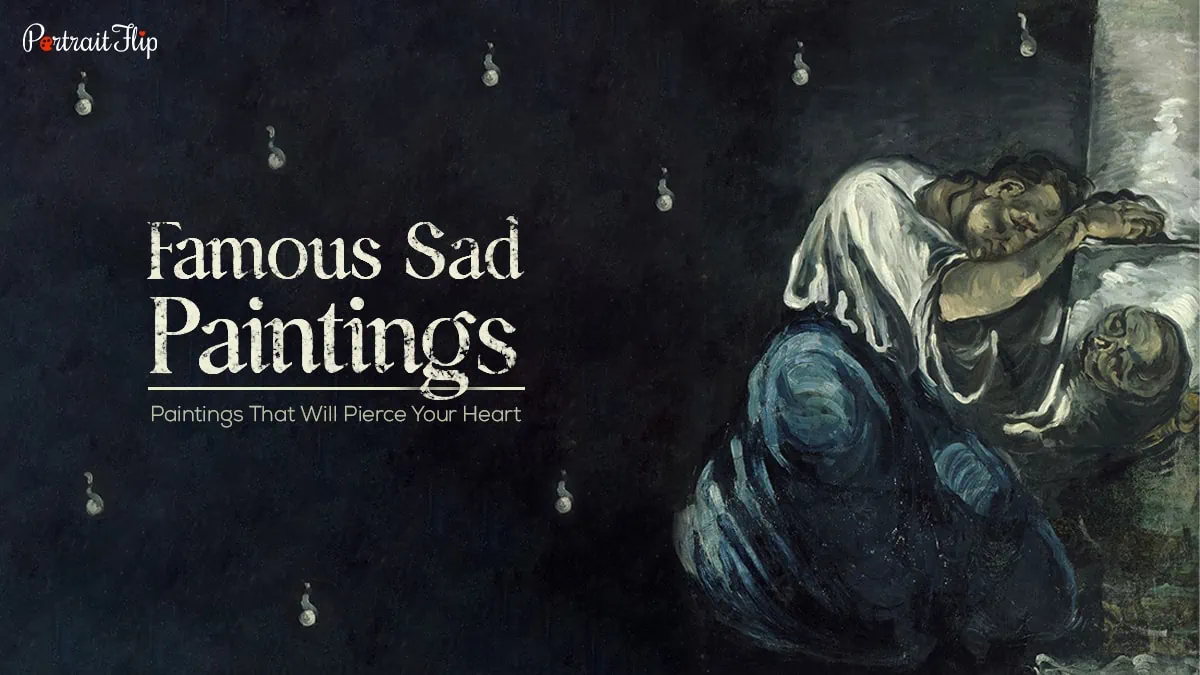My art is grounded in reflections on being different from others. My sufferings are part of myself and my art. They are indistinguishable from me, and their destruction would destroy my art. I want to keep those sufferings.”
Edvard Munch
This poignant quote by the famous expressionist artist explains exactly why many artists create paintings of sadness.
Art and sadness go hand in hand for many artists who have been responsible for creating famous sad paintings!
Haven’t you come across sad paintings that felt heart-wrenching and left you pondering over them?
If not, I have come up with 12 such famous sad paintings that will move you!
These famous sad paintings are packed with emotions and the deep inner meaning of life and give us a peek into the artist’s psyche.
So buckle up and grab your tissues, because you are in for an emotional ride!
Table of contents
- St. Jerome in his Study by Candlelight by Aertan Van Leyden (1520)
- La Melancolie by Louis-Jean-François Lagrenee (1785)
- Sorrow by Paul Cezanne (1869)
- L’Absinthe by Edgar Degas (1876)
- The Sad Message by Peter Fendi (1838)
- Les Saltimbanques by Gustav Dore (1874)
- Inconsolable Grief by Ivan Kramskoy (1884)
- At Eternity’s Gate by Vincent van Gogh (1890)
- Femme Assise by Pablo Picasso (1902-1903)
- The Old Guitarist by Pablo Picasso (1903-1904)
- The Wounded Deer by Frida Kahlo (1946)
- Christina’s World by Andrew Wyeth (1948)
- Author’s Greetings!
- Frequently Asked Questions
St. Jerome in his Study by Candlelight by Aertan Van Leyden (1520)

The first famous sad painting that I am bringing to your attention is dated back to the 16th century!
Aertan van Leyden, a Dutch painter, created this sad art. He was known for being an artist who painted several artworks on Jesus and on religious themes.
St. Jerome was one of the well-known religious figures in the 16th century.
In this particular sad painting, he is seen sitting in a dark room with just a single candlelight.
While his head sadly rests on one hand, the other hand is seen holding a skull that is kept on his lap.
Isn’t it eerily intriguing?? I thought so too!
The colors used are somber, dark hues, with some warm shades here and there.
It is now preserved in the Rijksmuseum, Amsterdam, Netherlands.
La Melancolie by Louis-Jean-François Lagrenee (1785)

La Melancolie by Louis-Jean-Francois is one of the most famous sad paintings of our time, completed in 1785!
There is something intriguing about this painting of a woman that is mixed with disparity and suffering, which moves its viewers like nothing else!
The medium used for this sad art was oil paint on canvas, and it is now housed in the Louvre Museum in Paris, France.
Everything about this sad painting depicts despondency!
The subject of the painting is the young woman’s face with a sad, depressing expression with her gaze downward.
She is dressed in elegant, soft garments that reflect her flowing thoughts.
She is lost in her sad thoughts as she stares into oblivion.
The name, La Melancolie, or melancholy, is well represented through her body language.
The artist made sure that we viewers can feel her sadness, don’t you think?
Suggested Read: Famous Landscape Paintings
Sorrow by Paul Cezanne (1869)
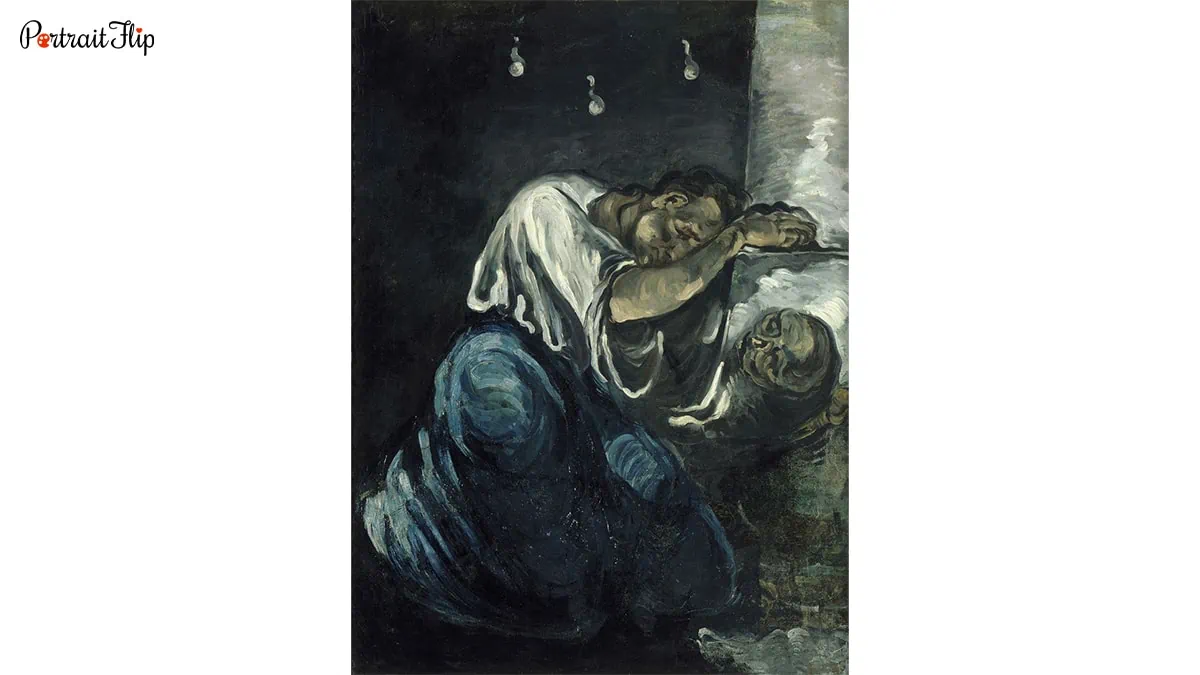
Paul Cezanne was a Post-Impressionist artist who believed in the magic of art and its potential to let one grieve!
This is one of the famous sad paintings where the artist draws a figure influenced from his own experience and emotions.
For Cezanne, grieving is not a result of death or loss here, but of the constant sadness a person feels throughout his life because of failures.
And here, he depicts the life of a failed artist.
If you look closely at the painting, you will notice something else than grief.
A sense of comfort and rest!
Almost as if the subject in the painting is tired and finally resting.
The colors used are again dim, somber shades with a tint of blue added, probably as a symbol of sadness.
Is it day time? Or is it night? One cannot say!
We only know that the figure is in a closed space, conversing with his grief while accepting his rest.
In the modern world, we can see signs of anxiety and depression in this painting, but in Cezanne’s times, it had no particular name.
The grief was just an overwhelming blanket that engulfed you!
To quote Cezanne, “I’ve embraced my grief. Now, it’s time to rest.”
Suggested Read- Post Impressionist Artists: The 7 Founding Fathers of Modern Art.
L’Absinthe by Edgar Degas (1876)
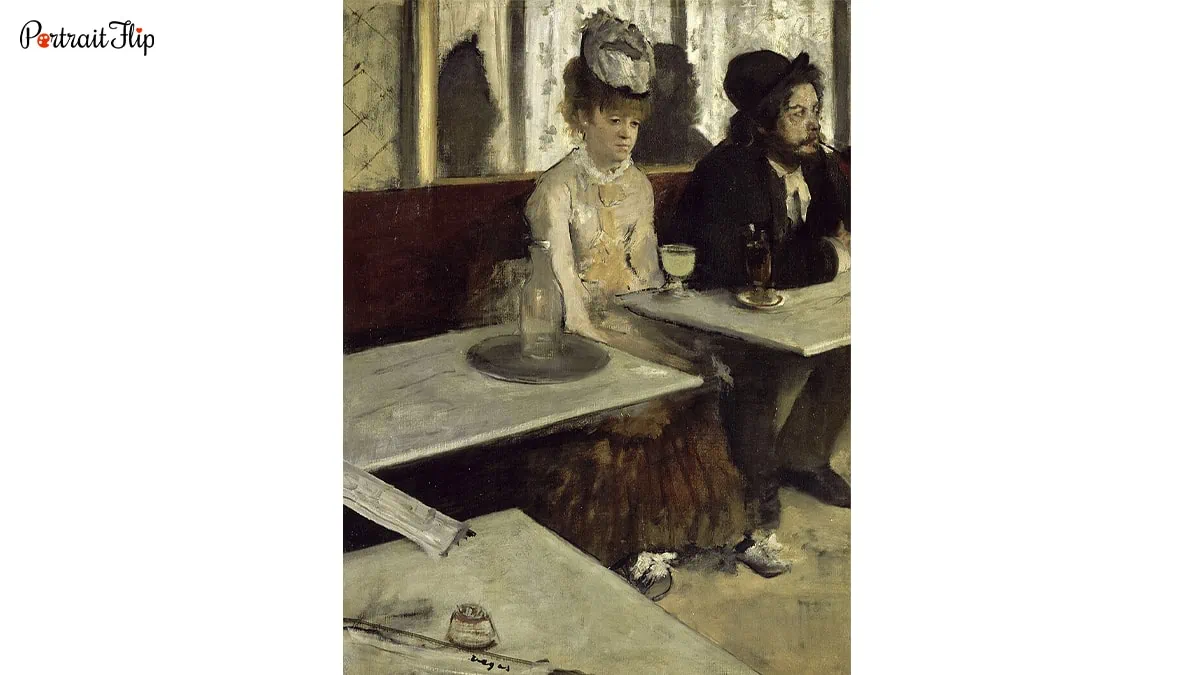
This is yet another real life moment that was turned into a famous sad painting by Edgar Degas, an Impressionist artist, in 1876.
Did you know that the two subjects in the painting are not strangers or fictional characters and are in fact Degas’ friends?
This sadness art is depicted with the drink Absinthe, which was very much in fashion and demand in this period.
The woman, who seems to be from high society, is shown sitting with a glass of Absinthe in front of her.
Her expression, although hollow, has a certain kind of despair and misery.
The brilliance of the painting is that one can interpret the woman’s expression as being lost in thoughts or lost in the intoxication of drinking Absinthe.
The hues are all almost monochrome, with only the hues of yellow standing out and the rest being brown and black.
From where I look, it seems like he tried splashing a light tint of Absinthe all over the painting!
Suggested Read: Famous Still Life Paintings
The Sad Message by Peter Fendi (1838)

This is personally one of the most heart wrenching famous sad paintings I have come across!
The Sad Message by Peter Fendi was completed in 1838, and now rests in the Vienna Museum, Austria.
The scene discloses a woman with her two young children receiving the news of the demise of her soldier husband.
She buries face in grief, with her infant on her lap, and a toddler over her shoulders.
The officer who comes with the sad message, also expresses grief and respect to the departed, as he carries the late soldier’s uniform in his hands.
This sad art will truly leave you in tears when you notice that the living situation of the mother and children are not the best.
The artist chose bright colors, only to depict poverty and helplessness.
Also Read: Schizophrenia Art: Art Therapy Or An Expression Of Agony
Les Saltimbanques by Gustav Dore (1874)
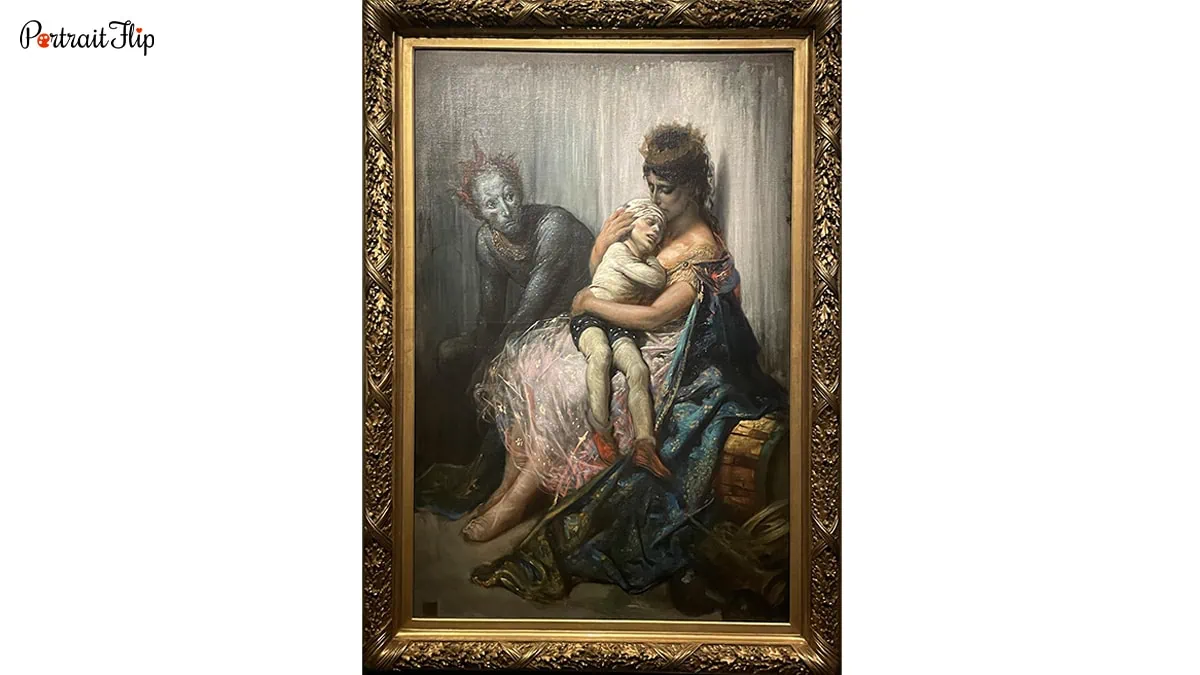
This is one of those famous sad paintings that is bound to move you to tears.
Les Saltimbanques is currently held at the Denver Art Museum and was completed in 1874.
This can be considered one of the most moving sad clown’s paintings, as you can see a circus family holding.
They are waiting in despair as they watch their child slowly slip into the hands of death with a head injury.
As depicted in the sad painting, each member of the family has a different role in the circus.
The artist shows the other side of the circus, where the misery lies in the lives of the entertainers, who suffer from fatal injuries and loss.
It covered emotions that could strongly touch you and carried a deep social message.
Hats off to the sad painter, who thought of showcasing these scenes at their best forms.
Suggested Reda: Mystery Behind Ivan the Terrible and His Son Painting Explained!
Inconsolable Grief by Ivan Kramskoy (1884)

This is a personal favorite when I look at my list of famous sad paintings.
The grieving woman, with her all black attire, tears-dried cheeks, sunken eyes, and the handkerchief that seems to be holding her whole world together!
The Inconsolable Grief by Ivan Kramskoy was completed in the year 1884.
What I personally love about this tragic painting is that there is so much more than grief that is portrayed.
Watch the woman’s face closely!
Even though her face is brimming with grief and despair of someone’s demise, there is also a sense of calmness and acceptance that the face is trying to achieve.
The artist’s brilliance lies in showing meaningful art with emotions that are transitioning from utmost grief to inevitable acceptance through this emotional art.
Her looking away from the study filled with flowers can also signify that no matter what the grief she is experiencing is definitely inconsolable.
This could also be the reason the woman is seen standing alone, even though she is dressed in funeral clothing, which signifed her loneliness in the journey of grief.
Kramskoy, known for his realist and humanist artworks, definitely would have pierced a hole in the heart through this sadness art!
Suggested Read: These 13 Realism Paintings Will Recite the Era’s Untold Stories.
At Eternity’s Gate by Vincent van Gogh (1890)
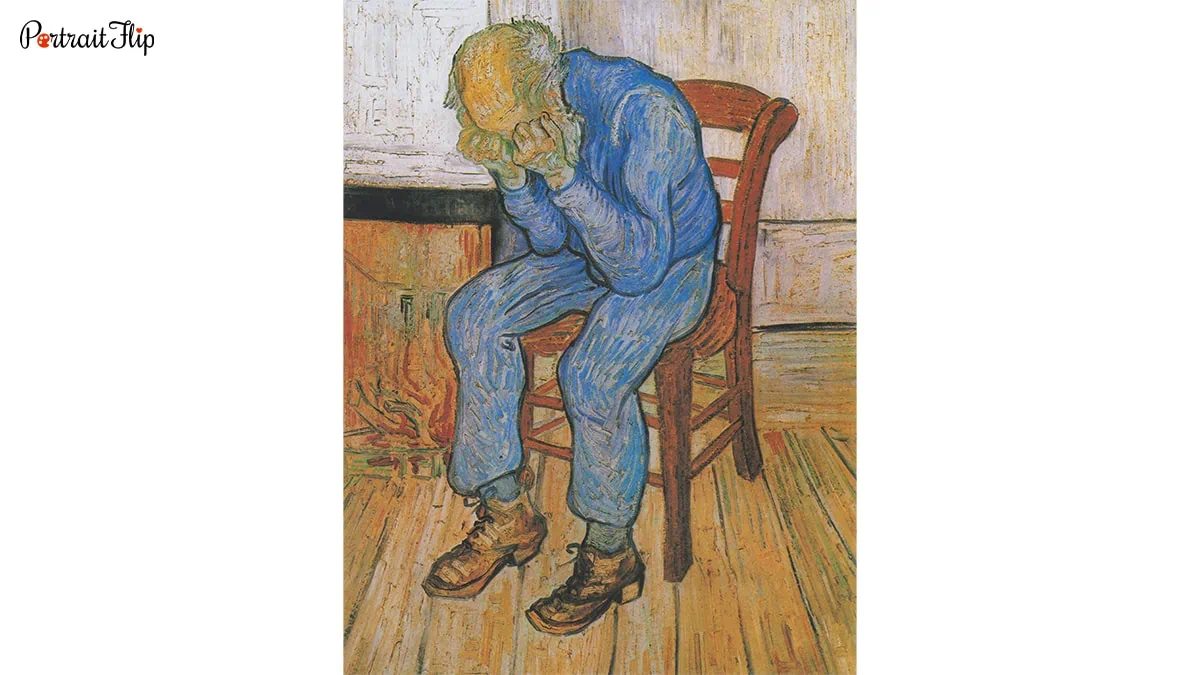
Another one among the famous sad paintings is the artwork done by none other than the revolutionary artist,Vincent van Gogh!
At Eternity’s Gate is one among the most famous paintings of van Gogh, that depicts melancholy and sadness like none.
This can be considered as one of the most moving depression art with deep meanings, that is to be uncovered by the viewer.
In this painting, the face does not talk, but everything is depicted through the body language of the subject .
The old man has his face buried in his hands, with a frail and tired body that is slouched.
He sits alone on a chair, with no one around, and his folded fingers suggests that he may be crying.
This despondency shows loneliness, of time, of age.
The colors used in the painting are the standard Van Gogh hues!
The yellow shades and the blue in his clothing, along with the signature brushstrokes, remind me of Van Gogh’s Starry Night!
I wonder if Vincent van Gogh saw himself in the old man. What do you think?
Femme Assise by Pablo Picasso (1902-1903)
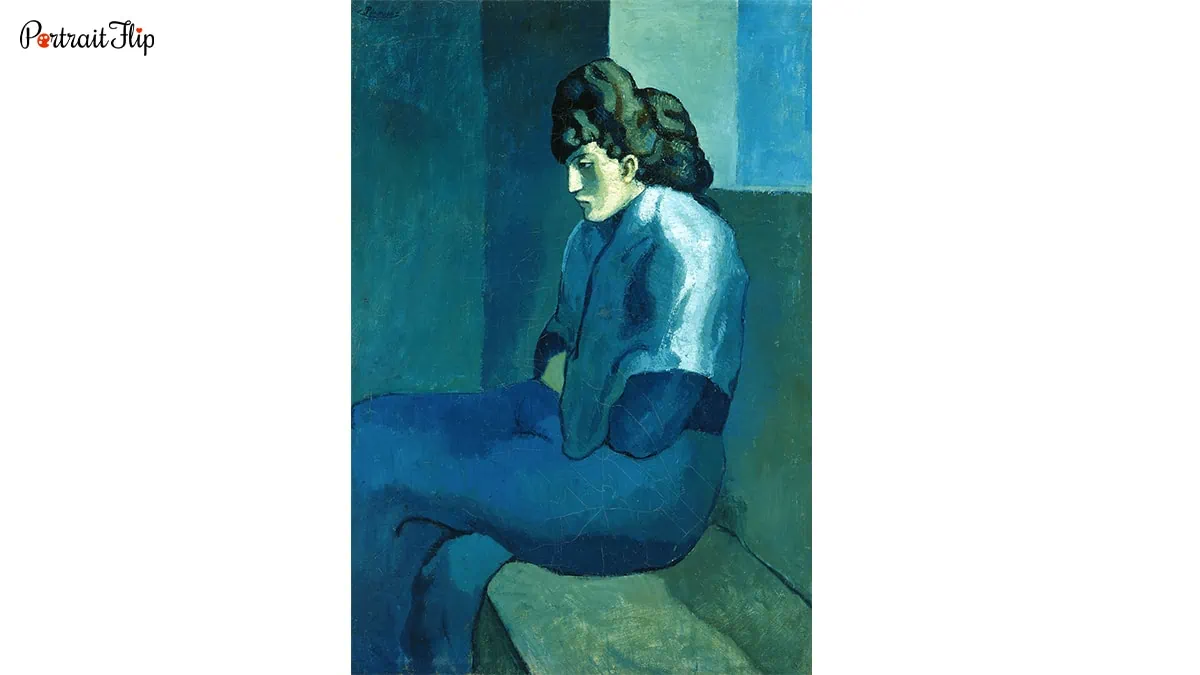
When it comes to Pablo Picasso, there is a whole period of famous sad paintings that you can choose from!
His Blue Period was filled with poverty and despondency, which he channeled through his paintings.
Pablo Picasso’s paintings are renowned, and the artist is also known for being the founder of the Cubism movement as well.
The Femme Assise which shows a seated Woman, is one such sad painting painted during Picasso’Blue Period.
A woman with a solemn, disappointed expression on her face, with hands tied across her, slouching
These sad art pieces are not just paintings, but a clear reflection of the artist’s mind, who was suffering from depression and anxiety.
This is also why Picasso was obsessed with painting everything in different hues of blue.
It is currently preserved at the Detroit Museum of Art, Michigan.
The Old Guitarist by Pablo Picasso (1903-1904)

The Old Guitarist is yet another famous sad painting from Pablo Picasso’s Blue Period collection.
This artist, who was influenced by the Surrealism movement, created a series of sadness art in this period that held deep symbolism.
This particular sad painting was created by Picasso months after his dear friend died of suicide.
Through this deep sad painting, Picasso tries to symbolize poverty and being cast out from society.
Did you know that this particular painting also has one of the most shocking painting mysteries around it?
You’d be surprised with what you find out!
The Wounded Deer by Frida Kahlo (1946)

The Wounded Deer is one of the most famous sad paintings by the enthralling artist, Frida Kahlo, which was completed in 1946.
Among the huge variety of paintings by Frida Kahlo, this particular sad painting stands out as it holds a lot of significance!
Did you know that The Wounded Deer is actually a public statement about her complicated relationship with her husband, Diego Rivera.
Both Kahlo and Rivera were well-known and famous Mexican artists of their time, and their relationship was not a smooth one.
The deer, which represents Frida Kahlo, is deeply wounded and hurt, with several arrows piercing her.
This sad art came from the emotions that she could not endure because of the infidelity by her husband.
Apart from the mental torment, she was also physically ill and in chronic pain after an accident.
She is yet another among the famous female artists who turn to art to cope with pain and misery through emotional deep drawings.
Christina’s World by Andrew Wyeth (1948)
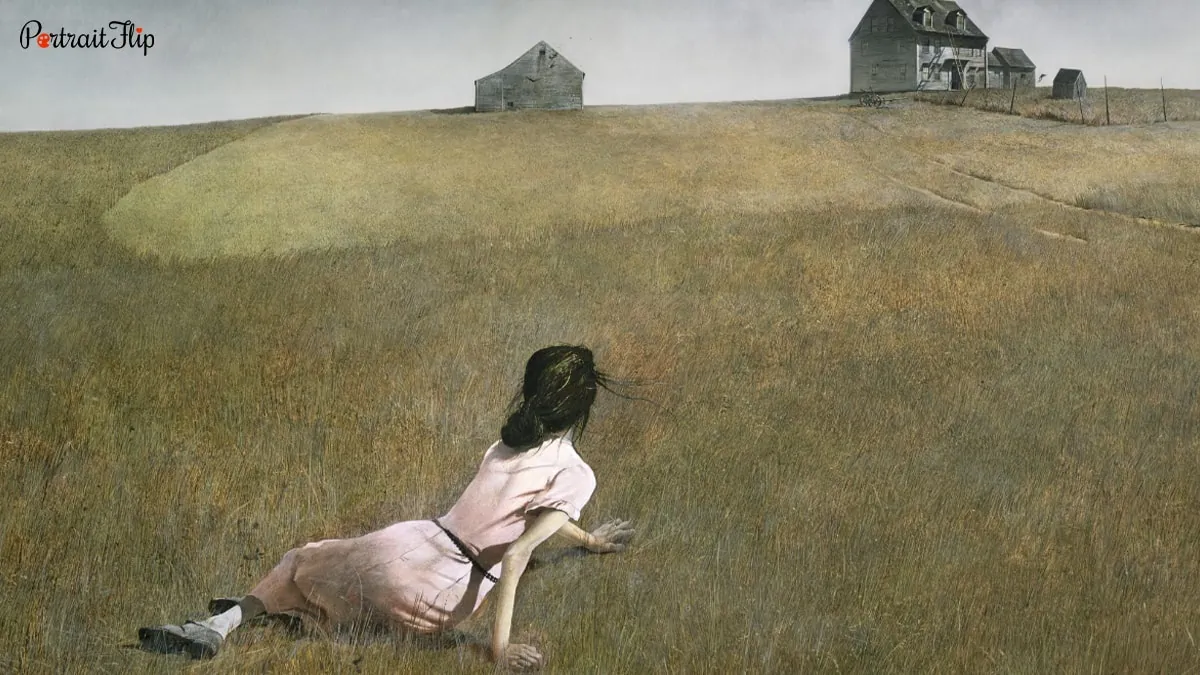
When you think of famous landscape paintings, you cannot miss out on the legendary sadness art by Andrew Wyeth, Christina’s World.
This goes right into one of the most famous sad paintings for the symbolism it holds.
What is special about it is that it may not come under the traditional depiction of sad art with deep meaning.
Meaning, the sadness being portrayed can be differently symbolized, something that was new at that time, 1948, when the painting was completed!
This sad painting by Andrew Wyeth shows a girl who is paralyzed from her hips and below.
This tragic painting shows how the ideal life of the girl is right in front of her, across the field, but she is unable to achieve it because of her paralysis.
This particular depiction is also emphasized by using the toned down, mellow colors.
While it is tragic, I also believe that it is a powerful emotional drawing.
What if the artist meant to show that even a young woman like the one portrayed in the sad painting can dream of an ideal life?
What if, while it is also sad, it is equally encouraging and gives a sense of hope to the viewers?
Wouldn’t it be great to own a powerful emotional painting for your own humble abode?
Yes, that can be possible with PortraitFlip’s very own Reproduction Painting services.
Author’s Greetings!
Hello Fellow Art Lovers,
I hope you enjoyed reading this very emotional blog, and I am grateful for the time you have given it!
Are there any particular paintings that stood out for you?
Let us discuss in the comment section below.
I will see you soon with the next one.
Until then,
Cheers xx
Frequently Asked Questions
The Expressionism art movement helped influence and motivate artists to produce more sad paintings as it focused on expressing inner human agony and misery.the psychological started to get more attention with this movement.
The color that are frequently seen while creating sad art is blue. Artists have also used somber and darker shades of warmer colors, but the paintings are usually dim, dark or pale to depict sadness and loss.
This is similar to asking can we benefit from sad music. Art has a way of connecting to the human mind like no other medium does. Any form of art, uniquely connects with an individual, which makes them feel heard and related. So yes, sad paintings are equally important and have helped many to regulate their emotions.



